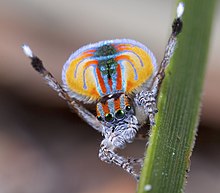
Fisherian runaway or runaway selection is a sexual selection mechanism proposed by the mathematical biologist Ronald Fisher in the early 20th century, to account for the evolution of ostentatious male ornamentation by persistent, directional female choice.[1][2][3] An example is the colourful and elaborate peacock plumage compared to the relatively subdued peahen plumage; the costly ornaments, notably the bird's extremely long tail, appear to be incompatible with natural selection. Fisherian runaway can be postulated to include sexually dimorphic phenotypic traits such as behavior expressed by a particular sex.
Extreme and (seemingly) maladaptive sexual dimorphism represented a paradox for evolutionary biologists from Charles Darwin's time up to the modern synthesis. Darwin attempted to resolve the paradox by assuming heredity for both the preference and the ornament, and supposed an "aesthetic sense" in higher animals, leading to powerful selection of both characteristics in subsequent generations.[3] Fisher developed the theory further by assuming genetic correlation between the preference and the ornament, that initially the ornament signalled greater potential fitness (the likelihood of leaving more descendants), so preference for the ornament had a selective advantage. Subsequently, if strong enough, female preference for exaggerated ornamentation in mate selection could be enough to undermine natural selection even when the ornament has become non-adaptive.[3] Over subsequent generations this could lead to runaway selection by positive feedback, and the speed with which the trait and the preference increase could (until counter-selection interferes) increase exponentially.[3]
Modern descriptions of the same mechanism using quantitative genetic and population genetic models were mainly established by Russell Lande and Mark Kirkpatrick in the 1980s, and are now more commonly referred to as the sexy son hypothesis.[4][5]


- ^ Andersson, M. (1994). Sexual selection. Princeton University Press. ISBN 0-691-00057-3.
- ^ Andersson, M.; Simmons, L.W. (2006). "Sexual selection and mate choice". Trends in Ecology and Evolution. 21 (6): 296–302. CiteSeerX 10.1.1.595.4050. doi:10.1016/j.tree.2006.03.015. PMID 16769428.
- ^ a b c d Gayon, J. (2010). "Sexual selection: Another Darwinian process". Comptes Rendus Biologies. 333 (2): 134–144. doi:10.1016/j.crvi.2009.12.001. PMID 20338530.
- ^ Kirkpatrick, Mark (1982). "Sexual Selection and the Evolution of Female Choice". Evolution, 36 (1): 1–12. https://doi.org/10.2307/2407961
- ^ Lande, R. (1980). Sexual Dimorphism, Sexual Selection, and Adaptation in Polygenic Characters. Evolution, 34 (2): 292–305. https://doi.org/10.2307/2407393